#India religious diversity
Text
#trinidad & tobago#caribbean diversity#anti hinduism#world anti hinduism#religious converts#india#indo caribbean#hindu caribbean#prejudice#fiji#hinduphobia
5 notes
·
View notes
Text
Abu Dhabi's First Hindu Temple Built with Pink Sandstone from Rajasthan, Holy Water from Ganga-Yamuna
Abu Dhabi’s First Hindu Temple Built with Pink Sandstone from Rajasthan, Holy Water from Ganga-Yamuna
Abu Dhabi’s First Hindu Temple Built with Pink Sandstone from Rajasthan, Holy Water from Ganga-Yamuna
Abu Dhabi is set to welcome its first Hindu temple, constructed with pink sandstone sourced from the deserts of Rajasthan, India. The sacred structure, dedicated to Hindu deities, stands as a…
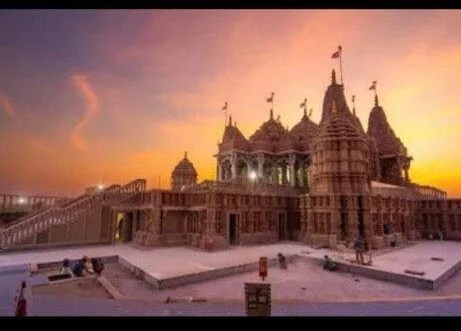
View On WordPress
#Abu Dhabi#cultural heritage#Ganga-Yamuna#Hindu temple#India-Abu Dhabi relations.#interfaith dialogue#pink sandstone#Rajasthan#religious diversity#religious harmony
0 notes
Text
#GoldenTemple#Amritsar#Punjab#Har mandir Sahib#Sikhism#Travel India#Spiritual Journey#Shorts Video#Travel Inspiration#Architectural Marvel#Cultural Heritage#DivineBeauty#Amrit Sarovar#Gurbani#Indian Architecture#Sacred Destination#Unity In Diversity#Incredible India#Cultural Exploration#Religious Heritage#Pilgrimage Site#Travel Experience#Sikh Culture#World Wonders#Virtual Travel#ExploreWithMe#Wander lust#Discover India#Travel Vibes
0 notes
Text
if only this country cared about its other religions just as much :/
1 note
·
View note
Text
Indian Prime Minister Narendra Modi is, by some measures, the most popular leader in the world. Prior to the 2024 election, his Bharatiya Janata Party (BJP) held an outright majority in the Lok Sabha (India’s Parliament) — one that was widely projected to grow after the vote count. The party regularly boasted that it would win 400 Lok Sabha seats, easily enough to amend India’s constitution along the party's preferred Hindu nationalist lines.
But when the results were announced on Tuesday, the BJP held just 240 seats. They not only underperformed expectations, they actually lost their parliamentary majority. While Modi will remain prime minister, he will do so at the helm of a coalition government — meaning that he will depend on other parties to stay in office, making it harder to continue his ongoing assault on Indian democracy.
So what happened? Why did Indian voters deal a devastating blow to a prime minister who, by all measures, they mostly seem to like?
India is a massive country — the most populous in the world — and one of the most diverse, making its internal politics exceedingly complicated. A definitive assessment of the election would require granular data on voter breakdown across caste, class, linguistic, religious, age, and gender divides. At present, those numbers don’t exist in sufficient detail.
But after looking at the information that is available and speaking with several leading experts on Indian politics, there are at least three conclusions that I’m comfortable drawing.
First, voters punished Modi for putting his Hindu nationalist agenda ahead of fixing India’s unequal economy. Second, Indian voters had some real concerns about the decline of liberal democracy under BJP rule. Third, the opposition parties waged a smart campaign that took advantage of Modi’s vulnerabilities on the economy and democracy.
Understanding these factors isn’t just important for Indians. The country’s election has some universal lessons for how to beat a would-be authoritarian — ones that Americans especially might want to heed heading into its election in November.
-via Vox, June 7, 2024. Article continues below.
A new (and unequal) economy
Modi’s biggest and most surprising losses came in India’s two most populous states: Uttar Pradesh in the north and Maharashtra in the west. Both states had previously been BJP strongholds — places where the party’s core tactic of pitting the Hindu majority against the Muslim minority had seemingly cemented Hindu support for Modi and his allies.
One prominent Indian analyst, Yogendra Yadav, saw the cracks in advance. Swimming against the tide of Indian media, he correctly predicted that the BJP would fall short of a governing majority.
Traveling through the country, but especially rural Uttar Pradesh, he prophesied “the return of normal politics”: that Indian voters were no longer held spellbound by Modi’s charismatic nationalist appeals and were instead starting to worry about the way politics was affecting their lives.
Yadav’s conclusions derived in no small part from hearing voters’ concerns about the economy. The issue wasn’t GDP growth — India’s is the fastest-growing economy in the world — but rather the distribution of growth’s fruits. While some of Modi’s top allies struck it rich, many ordinary Indians suffered. Nearly half of all Indians between 20 and 24 are unemployed; Indian farmers have repeatedly protested Modi policies that they felt hurt their livelihoods.
“Everyone was talking about price rise, unemployment, the state of public services, the plight of farmers, [and] the struggles of labor,” Yadav wrote...
“We know for sure that Modi’s strongman image and brassy self-confidence were not as popular with voters as the BJP assumed,” says Sadanand Dhume, a senior fellow at the American Enterprise Institute who studies India.
The lesson here isn’t that the pocketbook concerns trump identity-based appeals everywhere; recent evidence in wealthier democracies suggests the opposite is true. Rather, it’s that even entrenched reputations of populist leaders are not unshakeable. When they make errors, even some time ago, it’s possible to get voters to remember these mistakes and prioritize them over whatever culture war the populist is peddling at the moment.
Liberalism strikes back
The Indian constitution is a liberal document: It guarantees equality of all citizens and enshrines measures designed to enshrine said equality into law. The signature goal of Modi’s time in power has been to rip this liberal edifice down and replace it with a Hindu nationalist model that pushes non-Hindus to the social margins. In pursuit of this agenda, the BJP has concentrated power in Modi’s hands and undermined key pillars of Indian democracy (like a free press and independent judiciary).
Prior to the election, there was a sense that Indian voters either didn’t much care about the assault on liberal democracy or mostly agreed with it. But the BJP’s surprising underperformance suggests otherwise.
The Hindu, a leading Indian newspaper, published an essential post-election data analysis breaking down what we know about the results. One of the more striking findings is that the opposition parties surged in parliamentary seats reserved for members of “scheduled castes” — the legal term for Dalits, the lowest caste grouping in the Hindu hierarchy.
Caste has long been an essential cleavage in Indian politics, with Dalits typically favoring the left-wing Congress party over the BJP (long seen as an upper-caste party). Under Modi, the BJP had seemingly tamped down on the salience of class by elevating all Hindus — including Dalits — over Muslims. Yet now it’s looking like Dalits were flocking back to Congress and its allies. Why?
According to experts, Dalit voters feared the consequences of a BJP landslide. If Modi’s party achieved its 400-seat target, they’d have more than enough votes to amend India’s constitution. Since the constitution contains several protections designed to promote Dalit equality — including a first-in-the-world affirmative action system — that seemed like a serious threat to the community. It seems, at least based on preliminary data, that they voted accordingly.
The Dalit vote is but one example of the ways in which Modi’s brazen willingness to assail Indian institutions likely alienated voters.
Uttar Pradesh (UP), India’s largest and most electorally important state, was the site of a major BJP anti-Muslim campaign. It unofficially kicked off its campaign in the UP city of Ayodhya earlier this year, during a ceremony celebrating one of Modi’s crowning achievements: the construction of a Hindu temple on the site of a former mosque that had been torn down by Hindu nationalists in 1992.
Yet not only did the BJP lose UP, it specifically lost the constituency — the city of Faizabad — in which the Ayodhya temple is located. It’s as direct an electoral rebuke to BJP ideology as one can imagine.
In Maharashtra, the second largest state, the BJP made a tactical alliance with a local politician, Ajit Pawar, facing serious corruption charges. Voters seemingly punished Modi’s party for turning a blind eye to Pawar’s offenses against the public trust. Across the country, Muslim voters turned out for the opposition to defend their rights against Modi’s attacks.
The global lesson here is clear: Even popular authoritarians can overreach.
By turning “400 seats” into a campaign slogan, an all-but-open signal that he intended to remake the Indian state in his illiberal image, Modi practically rang an alarm bell for constituencies worried about the consequences. So they turned out to stop him en masse.
The BJP’s electoral underperformance is, in no small part, the direct result of their leader’s zealotry going too far.
Return of the Gandhis?
Of course, Modi’s mistakes might not have mattered had his rivals failed to capitalize. The Indian opposition, however, was far more effective than most observers anticipated.
Perhaps most importantly, the many opposition parties coordinated with each other. Forming a united bloc called INDIA (Indian National Developmental Inclusive Alliance), they worked to make sure they weren’t stealing votes from each other in critical constituencies, positioning INDIA coalition candidates to win straight fights against BJP rivals.
The leading party in the opposition bloc — Congress — was also more put together than people thought. Its most prominent leader, Rahul Gandhi, was widely dismissed as a dilettante nepo baby: a pale imitation of his father Rajiv and grandmother Indira, both former Congress prime ministers. Now his critics are rethinking things.
“I owe Rahul Gandhi an apology because I seriously underestimated him,” says Manjari Miller, a senior fellow at the Council on Foreign Relations.
Miller singled out Gandhi’s yatras (marches) across India as a particularly canny tactic. These physically grueling voyages across the length and breadth of India showed that he wasn’t just a privileged son of Indian political royalty, but a politician willing to take risks and meet ordinary Indians where they were. During the yatras, he would meet directly with voters from marginalized groups and rail against Modi’s politics of hate.
“The persona he’s developed — as somebody kind, caring, inclusive, [and] resolute in the face of bullying — has really worked and captured the imagination of younger India,” says Suryanarayan. “If you’ve spent any time on Instagram Reels, [you’ll see] an entire generation now waking up to Rahul Gandhi’s very appealing videos.”
This, too, has a lesson for the rest of the world: Tactical innovation from the opposition matters even in an unfair electoral context.
There is no doubt that, in the past 10 years, the BJP stacked the political deck against its opponents. They consolidated control over large chunks of the national media, changed campaign finance law to favor themselves, suborned the famously independent Indian Electoral Commission, and even intimidated the Supreme Court into letting them get away with it.
The opposition, though, managed to find ways to compete even under unfair circumstances. Strategic coordination between them helped consolidate resources and ameliorate the BJP cash advantage. Direct voter outreach like the yatra helped circumvent BJP dominance in the national media.
To be clear, the opposition still did not win a majority. Modi will have a third term in office, likely thanks in large part to the ways he rigged the system in his favor.
Yet there is no doubt that the opposition deserves to celebrate. Modi’s power has been constrained and the myth of his invincibility wounded, perhaps mortally. Indian voters, like those in Brazil and Poland before them, have dealt a major blow to their homegrown authoritarian faction.
And that is something worth celebrating.
-via Vox, June 7, 2024.
#india#narendra modi#pm modi#modi#bjp#lok sabha elections#rahul gandhi#democracy#2024 elections#authoritarianism#anti authoritarian#good news#hope
721 notes
·
View notes
Text

Batboys as Desi Films

𝐃𝐢𝐜𝐤 𝐆𝐫𝐚𝐲𝐬𝐨𝐧
Dilwale Dulhania Le Jayenge (1995)

Raj and Simran meet during a trip across Europe and end up getting stranded in the middle of nowhere after they miss their train. Despite their initial clashing, they fall in love. However, Simran’s traditional father has arranged her marriage elsewhere. Raj must win over Simran’s family to marry her, leading to a series of heartfelt moments, comedic misunderstandings, and ultimately, a dramatic climax where love conquers all as the couple fights for their happiness against societal norms.
Dick is so raj coded with his quips and charisma. Their chaotic banter and chemistry is off the charts. Any Indian who hasn’t watched this gets their desi card revoked immediately, I don’t make the rules. This movies fits Dick’s dramatic flair perfectly.

𝐉𝐚𝐬𝐨𝐧 𝐓𝐨𝐝𝐝
Goliyon ki Raasleela Ram-Leela (2013)
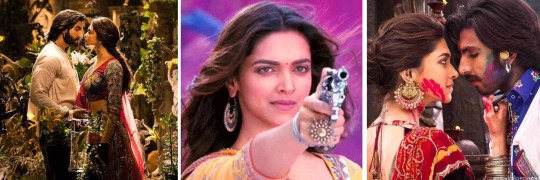
The modern adaptation of William Shakespeare’s “Romeo and Juliet,” set in rural Gujarat, India. It follows the love story of Ram, from the Rajadi clan and Leela, from the Sanera clan, who belong to rival gangster clans engaged in a long-standing feud. Despite the enmity between their families, Ram and Leela fall deeply in love, leading to a tragic and tumultuous journey filled with passion, violence, and sacrifice.
It fits Jason’s love for guns and classics. An absolute visual treat with cinematography and all the songs are absolute bangers.

𝐓𝐢𝐦 𝐃𝐫𝐚𝐤𝐞
Jab We Met (2007)

Aditya, a heartbroken business tycoon, someone who was dwelling in the lowest ebb of his life and was almost on the brink of giving it all up, aimlessly boards a train to escape his depressing life. On his journey he meets Geet, a talkative and vivacious young woman. Geet is on her way to meet her boyfriend, but her plans go awry, and she ends up stranded. Aditya, feeling sorry for her, decides to help her get to her destination safely. Along the way, they encounter various adventures and challenges that bring them closer together. Despite their contrasting personalities, they develop a deep connection. However, when they part ways, Aditya realizes his love for Geet and sets out to find her. In the end, they reunite, realizing they are meant to be together.
Grumpy x sunshine. The OG green flag. Epitome of ‘if he wanted to,he would’. Makes my chatterbox heart happy because of how much I relate to the FL. Favourite comfort movie of all time. ML kinda looks like Cillian Murphy’s scarecrow. “I like you a lot but that is my problem, you don’t need to worry about it.” Their fights and his little sassy comebacks and rants were so cute and fun to watch.

𝐃𝐚𝐦𝐢𝐚𝐧 𝐖𝐚𝐲𝐧𝐞
Jodhaa Akbar (2003)

The Mughal emperor Akbar, seeking to forge political alliances, marries Jodhaa, a Rajput princess. Initially a marriage of convenience, their relationship evolves as they learn to respect and love each other. Jodhaa struggles to adapt to Mughal customs, especially with their cultural and religious differences but her courage and integrity win Akbar's admiration. Despite conspiracies and opposition, including from Akbar's own court, their love prevails. The film explores the transformation of a young ruler, initially groomed for ruthlessness by his mentor Bairam Khan, into a wise and compassionate emperor who values mercy, diplomacy, religious harmony and cultural acceptance. Akbar's realization of the importance of religious tolerance, showcased through his abolition of discriminatory policies and his respect for all faiths.
The arranged marriage tag and the ‘raised as a weapon but softens and shows more compassion out of respect and love for his empress’ tag fits demonhead!Damian so much. The way he said mashallah after he pulled off her veil in the middle of a sword fight >>>>. I love how it captures the essence of India’s rich heritage and diversity. “Why seek paradise ? It is before me now.”

𝐁𝐫𝐮𝐜𝐞 𝐖𝐚𝐲𝐧𝐞
Khoobsurat (2014)
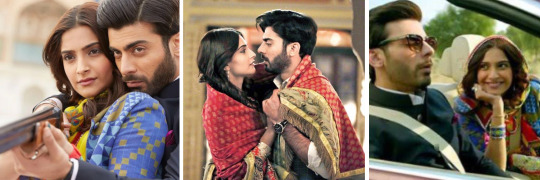
Milli, a free-spirited and eccentric young woman becomes the physiotherapist for a royal family. She brings her lively yet clumsy personality into the conservative royal household, shaking up their structured lives. It clashes with the formal atmosphere of the palace, especially with the stern matriarch, Nirmala Devi. Despite initial resistance, Milli's unconventional methods bring joy and laughter into the lives of the family members, including the brooding prince, Vikram. As Milli navigates the challenges of fitting into the royal household, she also finds herself falling in love with Vikram, leading to a series of comedic and heartwarming moments.
Very cliched (well it is a Disney film) and the second hand embarrassment is unreal but sometimes after a long day all you need is a feel-good cheesy rom-com. Oh to sit next to Fawad Khan in a red convertible while gazing lovingly at him. I like how she emphasises on improving the patient’s mental health to help him heal. Incase you haven’t noticed already, cold brooding™️ x silly goose is my favourite character dynamic.

𝐀/𝐍 - I’ll be honest with y’all, this was to satiate my desire of writing x desi! reader cuz I don’t have enough motivation or time to do it T^T

#batman#batfam#dick grayson#nightwing#dick grayson x reader#jason todd#red hood#red hood x reader#tim drake#red robin#tim drake x reader#damian al ghul#damian wayne#robin#damian wayne x reader#batboys#bruce wayne#batman x reader#bollywood#movies#bruce wayne x reader#ddlj#dilwale dulhania le jayenge#jab we met#khoobsurat#jodhaa akbar#ram leela
310 notes
·
View notes
Note
Not a gotcha, just curious:I saw you say Hinduism isn't the indigenous religion of India. Do you mean like. Modern Hinduism? That there is no indigenous religion for India? That there's another one that is indigenous?
if you could link me to the post where i said that i could be clearer but i could have meant it in two ways.
one, indigenity as a political formulation, which is about how historically hinduism has functioned as a powerful, dominant and subjugating force on other local indigenous traditions. tbf the hindu was to some extent a label used by the british to categorise diverse non abrahamic indian religious practices, and nationalist hinduism as understood by reformers and sanatanis responded to colonial pressures by recreating it into a unified vision. but even predating that it was still an assimilative force on several prexisting, mostly animist traditions that it otherised as 'dasa' (cognate: slave or servant) in the vedic literary texts. post independence modern hinduism continues also to perform the standardisation of upper caste practices through sanskritisation of lower caste ritual traditions. hindutva in the modern day for example insists that marriages that don't perform the seven rounds around the fire are illegitimate hindu marriages. the use of state run reservation schools that forcibly convert tribal children is a particulary egregious example of hinduism's non-indigenity in the political sense. less obviously, how anyone not muslim or christian is characterised as "hindu" in the personal codes – excluding the distinct histories of sikhs and jains and buddhists with several hundred year old recorded origins in the country.
two: i could have been invoking the aryan migration hypothesis which examines linguistic, archeological and genetic record to suggest aryan, and therefore vedic tradition migrated into the subcontinent from iran.
84 notes
·
View notes
Text
Please reblog for a bigger sample size!
If you have any fun fact about India, please tell us and I'll reblog it!
Be respectful in your comments. You can criticize a government without offending its people.
195 notes
·
View notes
Text
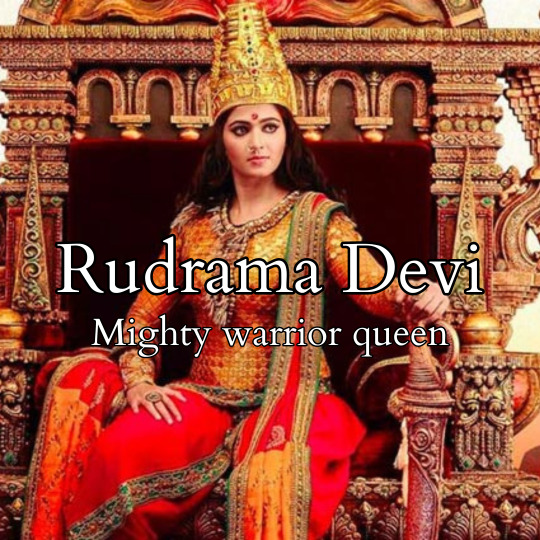
An unprecedented female monarch in her dynasty, Rudrama Devi (r.1262-1289) presided over an age of prosperity. A successful warrior queen, she triumphed over both internal and external threats.
Her father’s heir
Rudrama Devi was the daughter of King Ganapati Deva (r.1199-1262) of the Kakatiya dynasty, who ruled over parts of present-day Telangana and Andhra Pradesh in Southern India. Their capital was located at Orugallu (Warangal).
Ganapati Deva was a successful monarch. His kingdom was famed for its’ diamonds and beautiful fabrics. He had no son to succeed him and his older daughter was already married. He thus decided to make his younger daughter Rudrama Devi his heir and gave her the requisite training.
A female monarch would nonetheless be a in vulnerable position and see her legitimacy questioned. To make female rule more acceptable, he arranged a Putrikayagna ceremony for his daughter. This religious rite allowed a sonless man to declare his daughter or his daughter’s son as his son. After that, Rudrama Devi was also known by the masculine name of Rudra Deva. She also attended all public meetings in masculine attire.
Her story is similar in that regard to that of her near-contemporary, Raziya Sultan of Delhi.
A warrior among warriors
In 1259, Rudrama Devi became her father’s co-ruler and assumed sole rule in 1262. She married the Chalukya prince Virabdhadra, who played no part in her administration, and with whom she had three daughters.
Rudrama Devi faced many threats at once. Her neighbors saw an opportunity to conquer her kingdom and her feudatory noblemen couldn’t stand being ruled by a woman.
She stood her ground and prevailed, proving her might as a warrior queen. Many of her nobles rebelled, but she successfully defeated them. The Seuna Yadava king, Mahadeva, invaded her territories and reached her capital. Rudrama Devi chased him after 15 days of fighting and forced them to pay a heavy tribute in money and horses.
To commemorate her victory, she styled herself “Rayagajakesari” or “the lion who rules over the elephant kings”. In the pavilion she built, she was depicted as a warrior mounted on a lion, holding a sword and a shield, with an elephant trunk holding up a lotus to her in sign of submission.
In 1262, another of her neighbors occupied the Vengi region. She was able to recover it after 12 years of fighting. She was nonetheless unsuccessful in fending off the attacks of her southern rival Ambadeva.
Meritocratic policies
Rudrama Devi completed the construction of the nearly impregnable Warangal Fort. She bought large tracts of land under cultivation, increasing her kingdom’s revenue. She also recruited non-aristocratic warriors from diverse castes. Only 17 percent of her subordinates were of noble background. Prominent commanders could receive lands and become feudatory nobles. She thus established a new warrior class. Since the nobility had rejected her rule, this meritocratic policy allowed her to surround herself with loyal retainers.
Marco Polo, who mistook her for a widow of the previous king, wrote about her very flattering terms, calling her a “lady of much discretion” and a “lover of justice, of equity and of peace”.
A warrior to the end
At the end of her reign, she chose her grandson, Prataparudra, as her heir.
Rudrama Devi likely died in 1289 (though some sources date her death from 1295) according to an inscription made by a member of her army commemorating her recent death and that of her army chief. The cause and location of her death are unknown. She likely died facing Ambadeva's armies, leading her troops as she had always done.
Further reading
Gupta Archana Garodia, The women who ruled India, leaders, warriors, icons
Janchariman M., Perspectives in Indian History From the Origins to AD 1857
Talbot Cynthia, "Rudrama‐devi, Queen of Kakatiya dynasty (r. 1262–1289)", In: The Oxford Encyclopedia of Women in World History.
Talbot Cynthia, Precolonial India in Practice: Society, Region, and Identity in Medieval Andhra
#rudrama devi#13th century#history#women in history#women's history#historyedit#women's history month#india#indian history#queens#powerful women#women warriors#warrior women#historical figures#herstory
83 notes
·
View notes
Text
Stone Turtle of Karakorum, Mongolia, c. 1235-1260 CE: this statue is one of the only surviving features of Karakorum, which was once the capital city of the Mongol Empire
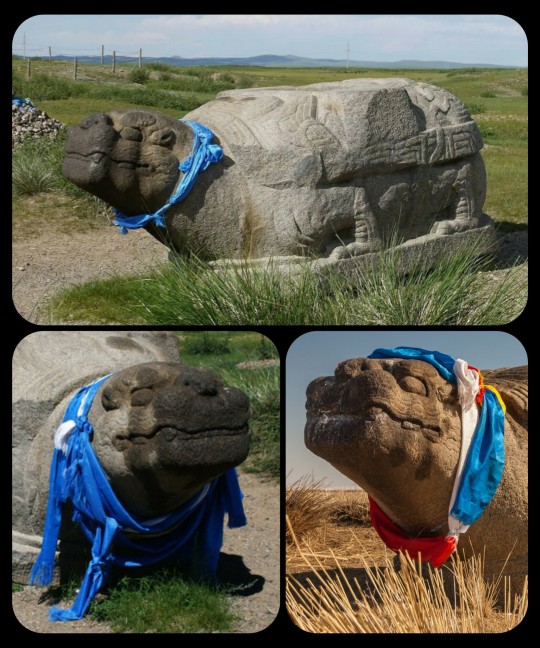
The statue is decorated with a ceremonial scarf known as a khadag (or khata), which is part of a Buddhist custom that is also found in Tibet, Nepal, and Bhutan. The scarves are often left atop shrines and sacred artifacts as a way to express respect and/or reverence. In Mongolia, this tradition also contains elements of Tengrism/shamanism.
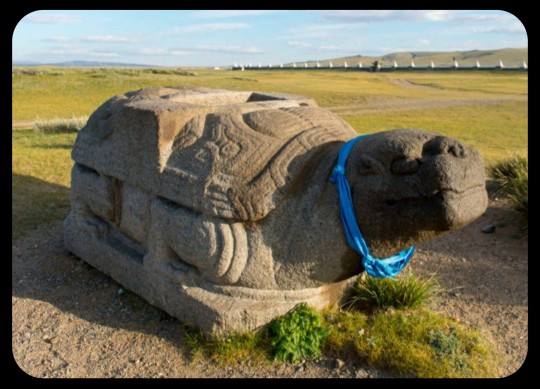
The city of Karakorum was originally established by Genghis Khan in 1220 CE, when it was used as a base for the Mongol invasion of China. It then became the capital of the Mongol Empire in 1235 CE, and quickly developed into a thriving center for trade/cultural exchange between the Eastern and Western worlds.
The city attracted merchants of many different nationalities and faiths, and Medieval sources note that the city displayed an unusual degree of diversity and religious tolerance. It contained 12 different temples devoted to pagan and/or shamanistic traditions, two mosques, one church, and at least one Buddhist temple.
As this article explains:
The city might have been compact, but it was cosmopolitan, with residents including Mongols, Steppe tribes, Han Chinese, Persians, Armenians, and captives from Europe who included a master goldsmith from Paris named William Buchier, a woman from Metz, one Paquette, and an Englishman known only as Basil. There were, too, scribes and translators from diverse Asian nations to work in the bureaucracy, and official representatives from various foreign courts such as the Sultanates of Rum and India.
This diversity was reflected in the various religions practised there and, in time, the construction of many fine stone buildings by followers of Taoism, Buddhism, Islam, and Christianity.
The prosperous days of Karakorum were very short-lived, however. The Mongol capital was moved to Xanadu in 1263, and then to Khanbaliq (modern-day Beijing) in 1267, under the leadership of Kublai Khan; Karakorum lost most of its power, authority, and leadership in the process. Without the resources and support that it had previously received from the leaders of the Mongol Empire, the city was left in a very vulnerable position. The residents of Karakorum began leaving the site in large numbers, until the city had eventually become almost entirely abandoned.
There were a few scattered attempts to revive the city in the years that followed, but any hope of restoring Karakorum to its former glory was then finally shattered in 1380, when the entire city was razed to the ground by Ming Dynasty troops.
The Erdene Zuu Monastery was later built near the site where Karakorum once stood, and pieces of the ruins were taken to be used as building materials during the construction of the monastery. The Erdene Zuu Monastery is also believed to be the oldest surviving Buddhist monastery in Mongolia.
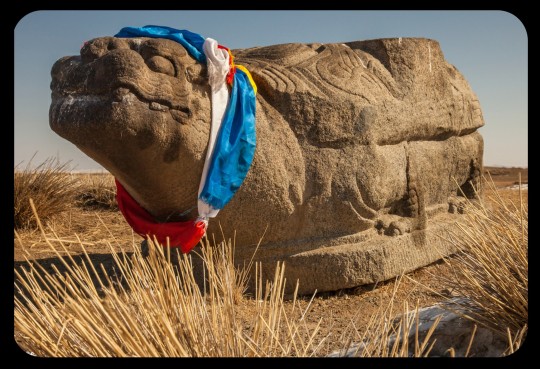
There is very little left of the ruined city today, and this statue is one of the few remaining features that can still be seen at the site. It originally formed the base of an inscribed stele, but the pillar section was somehow lost/destroyed, leaving nothing but the base (which may be a depiction of the mythological dragon-turtle, Bixi, from Chinese mythology).
This statue and the site in general always kinda remind me of the Ozymandias poem (the version by Horace Smith, not the one by Percy Bysshe Shelley):
In Egypt's sandy silence, all alone,
stands a gigantic leg
which far off throws the only shadow
that the desert knows.
"I am great OZYMANDIAS," saith the stone,
"the King of Kings; this mighty city shows
the wonders of my hand."
The city's gone —
naught but the leg remaining
to disclose the site
of this forgotten Babylon.
We wonder —
and some Hunter may express wonder like ours,
when thro' the wilderness where London stood,
holding the wolf in chace,
he meets some fragment huge
and stops to guess
what powerful but unrecorded race
once dwelt in that annihilated place
Sources & More Info:
University of Washington: Karakorum, Capital of the Mongol Empire
Encyclopedia Britannica: Entry for Karakorum
World History: Karakorum
#archaeology#history#anthropology#artifact#ancient history#mongol empire#mongolia#karakorum#middle ages#ancient ruins#art#turtle#bixi#ozymandias#poetry#mythology#genghis khan
240 notes
·
View notes
Photo
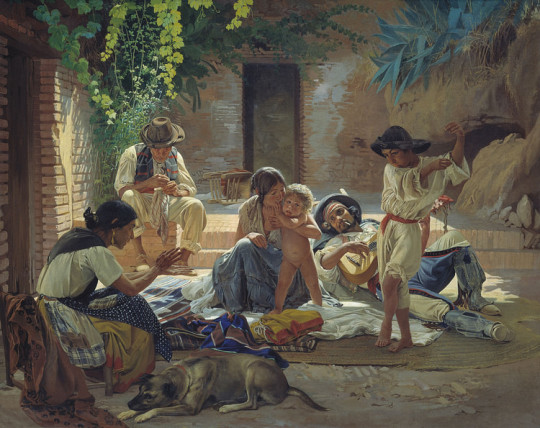
Romani
Romani is an umbrella term used to describe a diverse ethnolinguistic group of people with a historical presence in Europe and West Asia. The historically common term 'Gypsy' is based on the myth that they came from Egypt. In reality, the ancestors of the Romani migrated out of India in the 1st millennium CE.
During the European colonization of the New World, the first Romani arrived in the Americas as a result of slavery or deportation by European colonial powers. Romani immigrants began to voluntarily settle in North and South America in the 19th century. In the present, Romani communities are found throughout the world. Romani people share language and certain cultural similarities but encompass a wide range of social, cultural, and ethnic diversity.
Names & Identity
For most of history, there was no universal name for the Romani in their own language; different groups of Romani speakers and their descendants used different names for themselves and each other. The closest thing to an endonym in the Romani language is the word Rom/Romni, meaning a man or woman. In the present day, 'Romani' and 'Roma' are the most widely accepted umbrella terms for groups who speak or historically spoke Romani and have a common origin in the Indian subcontinent.
However, the Romani label is a modern invention intended to make it easier to discuss the overlapping history and experience of these groups and was not used this way prior to the 20th century. For most of history, there was no unified Romani identity or nation. The label is applied by historians to more conveniently refer to a number of communities which shared language and some cultural habits, but it should not be taken to mean that these groups were unified or homogenous. Contrary to the stereotype of Romani keeping themselves separate from society at large, European Romani were intimately connected to their neighbours and possessed a flexible cultural identity.
Different groups of Romani speakers have historically used their own endonyms. 'Roma' is widely used among Romani originating in Central and Eastern Europe. The Finnish Kaale and the Calé of the Iberian peninsula use names derived from kalo (meaning "black" in Romani). Other notable peoples include the Sinti of northwestern Europe, the Manouche of France and Belgium, and the Romanichal found in English-speaking countries. Many Romani clans and subgroups have been known by their historical professions, such as the Kalderash (lit. "coppersmiths").
Several names have been given to the Romani by outsiders, often based on misconceptions about them. The English word 'Gypsy' comes from the myth that the Romani originated in Egypt. Over time, it came to be used broadly for many nomadic or semi-nomadic groups in Eurasia. In the modern day, the term 'Gypsy' is often considered offensive, although it is used by some Romani. Gypsy is often used academically as an umbrella term to include both Romani and other nomadic peoples historically labeled 'Gypsies.'
Numerous European languages use words derived from the Greek word Atsingani or Athingani to describe Romani, such as the French Tzigane or Portuguese Cigano. The original Greek likely derives from Athinganoi, the name of a heretical Christian sect in the Byzantine Empire, and may have been applied to the Romani due to their foreign religious practices or association with fortune-telling.
The history of the Romani is intertwined with that of other minority groups, particularly nomadic peoples of Europe and the Middle East. The Lom of Armenia and the Dom found throughout North Africa and the Middle East share commonalities with Romani and likely share an Indian origin. The Romani, Domari, and Lomavren languages are thought to have originated from the same group of Central Indian languages. The term Gypsy has historically also been applied to other European nomadic peoples such as Irish Travellers and the Yenish of Western Europe, who have different origins than the Romani.
Continue reading...
46 notes
·
View notes
Text
The Synagogue of Singapore: A Historical Overview
As someone with a rich Jewish heritage, the history of the Maghain Aboth Synagogue in Singapore holds a special place in my heart. This synagogue represents not only the perseverance and unity of the Jewish community but also my personal connection to a legacy that has endured for generations. It's a beacon of faith, culture, and history that resonates deeply with my sense of identity and belonging.
The Maghain Aboth Synagogue, located in Singapore, is the oldest Jewish synagogue in Southeast Asia. Established in 1878 by the Jewish community, primarily comprised of Sephardic Jews from Baghdad, it has served as a central place of worship and community for over a century.
The Jewish presence in Singapore dates back to the early 19th century, with traders and merchants arriving from regions such as India, Iraq, and Persia. As the community grew, the need for a dedicated place of worship became evident. The Maghain Aboth Synagogue was constructed on Waterloo Street, designed in a neoclassical style that blends with Singapore's diverse architectural landscape.
Over the years, the synagogue has witnessed significant events, including World War II, when it served as a refuge and community center during the Japanese occupation. Despite the challenges, it remained a steadfast symbol of the Jewish faith and resilience in Singapore.
In the 20th century, the synagogue underwent renovations to preserve its structure and accommodate the growing community. It continues to serve as the focal point for Jewish religious life in Singapore, hosting services, festivals, and cultural events.
Today, the Maghain Aboth Synagogue stands as a testament to the enduring legacy and contributions of the Jewish community in Singapore. It not only represents a place of worship but also a historical landmark reflecting the multicultural tapestry of the city-state.
Axel Laniez

#synagogue#singaporesynagogue#jewish#jewish history#judaism#beauty#tolerance#heritage#singapore#southeast asia#travel#asia#Southeast Asia#sea
26 notes
·
View notes
Text



Buddhism
Siddhartha Gautama, the founder of Buddhism who later became known as “the Buddha,” lived during the 5th century B.C.
Gautama was born into a wealthy family as a prince in present-day Nepal. Although he had an easy life, Gautama was moved by suffering in the world.
He decided to give up his lavish lifestyle and endure poverty. For nearly six years, he undertook fasting and other austerities, but these techniques proved ineffectual and he abandoned them. He eventually promoted the idea of the “Middle Way,” which means existing between two extremes. Thus, he sought a life without social indulgences but also without deprivation.
After regaining his strength, he seated himself under a Bodhi tree in west-central India and promised not to rise until he had attained the supreme enlightenment. After fighting off Mara, an evil spirit who tempted him with worldly comforts and desires, Siddhartha reached enlightenment, becoming a Buddha at the age of 35. He spent the rest of his life teaching others about how to achieve this spiritual state.
When Gautama passed away around 483 B.C., his followers began to organize a religious movement. Buddha’s teachings became the foundation for what would develop into Buddhism.
In the 3rd century B.C., Ashoka the Great, the Mauryan Indian emperor, made Buddhism the state religion of India. Buddhist monasteries were built, and missionary work was encouraged.
Over the next few centuries, Buddhism began to spread beyond India. The thoughts and philosophies of Buddhists became diverse, with some followers interpreting ideas differently than others.
In the sixth century, the Huns invaded India and destroyed hundreds of Buddhist monasteries, but the intruders were eventually driven out of the country.
Islam began to spread quickly in the region during the Middle Ages, forcing Buddhism into the background. Nonetheless, Buddhism eventually spread to Central and Southeast Asia, China, Korea, Japan and, in the 20th century, to the West.
Buddhism Beliefs and Practices
Some key Buddhism beliefs include:
Followers of Buddhism don’t acknowledge a supreme god or deity. They instead focus on achieving enlightenment—a state of inner peace and wisdom. When followers reach this spiritual echelon, they’re said to have experienced nirvana.
The religion’s founder, Buddha, is considered an extraordinary being, but not a god. The word Buddha means “enlightened.”
The path to enlightenment is attained by utilizing morality, meditation and wisdom. Buddhists often meditate because they believe it helps awaken truth.
There are many philosophies and interpretations within Buddhism, making it a tolerant and evolving religion.
Some scholars don’t recognize Buddhism as an organized religion, but rather, a “way of life” or a “spiritual tradition.”
Buddhism encourages its people to avoid self-indulgence but also self-denial.
Buddha’s most important teachings, known as The Four Noble Truths, are essential to understanding the religion.
Buddhists embrace the concepts of karma (the law of cause and effect) and reincarnation (the continuous cycle of rebirth).
Followers of Buddhism can worship in temples or in their own homes.
Buddhist monks, or bhikkhus, follow a strict code of conduct, which includes celibacy.
There is no single Buddhist symbol, but a number of images have evolved that represent Buddhist beliefs, including the lotus flower, the eight-spoked dharma wheel, the Bodhi tree and the swastika (an ancient symbol whose name means “well-being” or “good fortune” in Sanskrit).
Types of Buddhism
Today, many forms of Buddhism exist around the world. The three main types that represent specific geographical areas include:
Theravada Buddhism: Prevalent in Thailand, Sri Lanka, Cambodia, Laos and Burma
Mahayana Buddhism: Prevalent in China, Japan, Taiwan, Korea, Singapore and Vietnam
Tibetan Buddhism: Prevalent in Tibet, Nepal, Mongolia, Bhutan, and parts of Russia and northern India
Zen Buddhism is a form of Mahayana Buddhism that’s practiced in many of the same areas. It emphasizes simplicity and meditation—the word “zen” means meditation—in lieu of religious scripture, ceremonies or doctrines.
Nirvana Buddhism is closely related to Theravada Buddhism, but the concept of nirvana is also central to many paths of Buddhism. The term nirvana means “blowing out,” as a candle is blown out, thus ending all attachment and desire to achieve a state of pure enlightenment.
Each of these types reveres certain texts and has slightly different interpretations of Buddha’s teachings.
Some forms of Buddhism incorporate ideas of other religions and philosophies, such as Taoism and Bon.
Dharma
Buddha’s teachings are known as “dharma.” He taught that wisdom, kindness, patience, generosity and compassion were important virtues.
Specifically, all Buddhists live by five moral precepts, which prohibit:
Killing living things
Taking what is not given
Sexual misconduct
Lying
Using drugs or alcohol
Four Noble Truths
The Four Noble Truths, which Buddha taught, are:
The truth of suffering (dukkha)
The truth of the cause of suffering (samudaya)
The truth of the end of suffering (nirhodha)
The truth of the path that frees us from suffering (magga)
Collectively, these principles explain why humans hurt and how to overcome suffering.
Eightfold Path
The Buddha taught his followers that the end of suffering, as described in the fourth Noble Truths, could be achieved by following an Eightfold Path.
In no particular order, the Eightfold Path of Buddhism teaches the following ideals for ethical conduct, mental disciple and achieving wisdom:
Right understanding (Samma ditthi)
Right thought (Samma sankappa)
Right speech (Samma vaca)
Right action (Samma kammanta)
Right livelihood (Samma ajiva)
Right effort (Samma vayama)
Right mindfulness (Samma sati)
Right concentration (Samma samadhi)
Buddha by Talon Abraxas
20 notes
·
View notes
Text
Indian Prime Minister Narendra Modi inaugurated the Ram temple in Ayodhya in the key northern state of Uttar Pradesh in January in hopes it would earn him a massive victory in the national election that concluded in June. That didn’t happen—at least not to the extent that Modi, his Hindu-nationalist Bharatiya Janata Party (BJP), and their ideological fountainhead Rashtriya Swayamsevak Sangh (RSS) expected.
In what has widely been described as a shock result, the BJP won merely 240 seats in the 543-seat parliament, after setting a target of 400 seats. Modi has formed a government but only with support from other parties.
Like any election result, the outcome had multiple causes that will take time to fully sort out. But one thing is already clear: Modi failed in his long-running bid to homogenize India’s Hindus across castes and cultures and consolidate their vote for his political benefit.
In 2014, Modi came to power on the back of religious nationalism and security issues, and he continued that trend in 2019. This year, in the absence of any urgent security threat from regional rival Pakistan and rising concerns over unemployment, inflation, and authoritarianism, Modi banked on the RSS’s homogenization strategy.
The Ram temple was built on a site long disputed with Muslims, where a 16th-century mosque stood until December 1992, when a group of Hindu nationalists razed it to the ground allegedly on the BJP’s provocation. Experts said the BJP had envisaged the temple would instill pride in Hindus, feed their Muslim animosity, and bring them under the Hindu umbrella to choose Modi.
Even though, by and large, the Hindu community seemed to have been pleased with the inauguration of the temple, that didn’t translate into votes for Modi across the Hindu hierarchy. Instead, the results exposed the weaknesses of the homogenization exercise.
Hartosh Singh Bal, an Indian journalist and the executive editor of the Caravan, said there is “diversity in Hinduism” and the election results prove that it can’t be “papered over by directing attention and hatred outwards” toward Muslims. This election proves that “Hindus are not a monolith” and that “various segments of Hinduism have a successful chance of taking on the BJP,” he added in reference to tactical voting by lower castes in Uttar Pradesh against the BJP.
Karthick Ram Manoharan, a political scientist at the National Law School of India University in Bengaluru, said that in Tamil Nadu, a state in southern India with the second-biggest economy in the country, the BJP did not win a single seat out of a total of 39.
“Hindus are the absolute majority in Tamil Nadu, but they still mostly vote for the secular Dravidian parties,” Manoharan said in reference to local parties that have emerged out of social movements opposed to an upper-caste Hindu order that the BJP and RSS have been long accused of nurturing and propagating.
In March, just a month before voting began, I witnessed saffron-colored flags expressing support for Modi’s party jutting out from rooftops and windows in tightly packed homes in western Uttar Pradesh. Some people I spoke to said that BJP workers had decided to adorn the neighborhoods as they pleased, but underneath the flag-waving, a large-scale discontent was brewing over a lack of employment opportunities.
The upper-caste youth seemed confused, if not yet disenchanted, with Modi and in the absence of industry and strong local economies once again mourned the loss of government jobs to affirmative action. (The Indian Constitution reserves almost half of all state jobs for people from lower castes and others who confront a generational disadvantage and historical discrimination.)
Meanwhile, Dalits, who sit at the bottom of India’s Hindu hierarchy, in hamlets nearby who depend on the quota for their dignity and livelihood were quietly recalibrating their options. The mood was starkly different from 2014 and 2019 when I visited some of the Dalit-dominated parliamentary seats in Uttar Pradesh. Back then, Dalits I met were upbeat and decisively pro-Modi. They said they supported him since they believed that he might raise their stature in the Hindu hierarchy.
But 10 years later, they suspected the BJP was plotting to weaken the constitution, the only assurance of rights for marginalized communities in a country where upper-caste Hindus continue to hold social capital and economic power.
Recent comments by BJP leaders that if Modi won 400 seats, he would change the constitution spread anxiety among lower castes that the party intended to scrap the reservation system. The BJP repeatedly denied this, but the suspicion that it is first a party for upper-caste Hindus is deep-rooted among lower castes, and experts believe the comments were part of the BJP’s political strategy.
“They were testing the waters to see what would be the reaction,” said Sushil Kumar Pandey, an assistant professor of history at Babasaheb Bhimrao Ambedkar University in Lucknow and the author of Caste and Politics in Democracy.
“The opposition picked it up and campaigned on it, telling people a change in the constitution could mean losing your livelihood, your jobs,” Pandey added. “That worked at a time [when] people were also scared of privatization” and in government-run sectors.
For Dalits, it was about more than jobs. The Indian Constitution is nearly worshipped by the community and celebrated en masse on the birth anniversary of the Indian intellectual who wrote it. B.R. Ambedkar was no fan of Ram and advocated against the caste discrimination inherent in Hinduism all his life, even converting to Buddhism when he felt there was no escaping caste-based prejudice. While he couldn’t annihilate the caste system, he ensured that the constitution offered lower castes a quota in government jobs to gradually uplift them.
In his honor, and as an ode to the progressive document, Dalits sing songs in praise of the constitution and hail it as the upholder of their dignity in a society where they continue to be belittled. Any change to the text was unacceptable. “Their cultural identity is linked to this book,” said Ravish Kumar, a journalist and the host of a popular YouTube news show.
In the south, too, there was a fear of culturally being subsumed by a Hindi-speaking upper-caste elite. Indian federal units, or states, were defined in the 1950s on the basis of language, and to this day south Indians identify themselves on the basis of the language they speak. The Ram temple had no resonance in the southern states, particularly in electorally significant Tamil Nadu, with the highest number of seats regionally. Tamils were wary that the RSS’s homogenization agenda would drown out their cultural ethos and impose a secondary status on the Tamil language.
Manoharan, the political scientist, said that in Tamil Nadu, it was “not so much religious but fear of cultural homogeneity” and “a language policy which will give importance to Hindi speakers over Tamil speakers and upper-caste Tamils over other backward castes.”
In a state where “88 percent people come from so-called lower castes” and “69 percent have jobs under affirmative action through a special act,” people were also extremely worried that the BJP may “water down” the employment quota promised in the constitution, Manoharan added.
The southern Indian states have a longer history of resistance to upper-caste domination, a higher literacy rate, better economies, and a tradition of secular politics. While the BJP maintained its tally of 29 seats from the last election, it is being seen as a poor result considering the inroads the RSS has made in the south.
For instance, in the southwestern state of Kerala, the RSS has more than 5,000 shakhas, or branches, second in number only to Uttar Pradesh, India’s most populous state—yet “despite the fact that the RSS has thousands of training grounds in Kerala, they are unable to get influence,” said K.M. Sajad Ibrahim, a professor of political science at University of Kerala. “That’s because while religion is important, communal harmony is more important to people here. BJP tries to create tensions, and that doesn’t work here.”
The BJP managed to gain one seat for the first time in Kerala, but that isn’t being attributed to its ideological success or expansion of homogenization project but to the winning candidate’s personal appeal. Suresh Gopi, the winning candidate, is a popular movie star.
In many states in the Hindi belt and even in the south, the BJP did well. The upper castes and urban voters are standing firmly behind Modi. Kumar, the journalist, said it would be foolhardy to dismiss Modi—and the bigger Hindutva, or Hindu nationalist, forces backing him—just yet. He said Hindutva hasn’t lost and only faced a setback. “The BJP was trying to dominate caste politics with Hindutva,” he said, “but the election result shows that dominance has cracked.” However, he added, “it has only cracked—the ideology still has wide-scale acceptance.”
Everyone else Foreign Policy spoke to concurred but added that Hindus are far too diverse to be homogenized. Manoharan said the results exposed the weakness of the homogenization agenda and its faulty premise. “Hindutva’s aim for homogeneity is confounded precisely by a structural feature of the religion-culture it seeks to defend—caste,” he said.
22 notes
·
View notes
Text

Traditional v.s Modern Astrology
I'm still studying Modern Astrology and found out that most people here used Modern Astrology, yet they are able to "at least" predict the future or have some thoughts about it which I think quite unusual because Modern astrology is more of a humanistic approach, which means it examines how the person's value for himself or herself, the development of self-awareness, and cultural diversity affect the future of humanity. This makes the predictions more accurate, and it is not focused on the event itself. (Remember the Carl Jung influence) . So don't fkvng believe them.
While in Traditional Astrology is more on judgemental. They are obsessed with prediction of events, and more often than not...It's limiting a person's beliefs, which makes them rely only on astrologers. That's why it seems so real, when it's not. esp if you followed their advice. Why? because as people develop self awareness, self relience and faith (from above or whatever) it actually effects their doings. Actions can determine the future. So here's the question why I'm into astrology? I don't event know, and half of me testing how accurate it was. I'm seeking for the truth. It makes me apply a different approach when giving interpretation. I think this is somehow connected so you need to be at least familiar with various astrology approaches. And since I'm studying traditional astrology (Hellinistic from Greek and hebrew and Vedic Astro from India) even tho there is you know religious touch on it. There is a give and take process.
More on, astrology is more signs of what you can do, your potential, and the inner you that needs to be explored and healed as part of your self- and career development. At all, Astrology is real (if you read it in Whole system) since it could be a map, but doesn't give you exact detailed of your future.
—Plagiarism is a Crime—
#astrology observation#astro notes#astrology#astro community#astro tumblr#astro thoughts#writers on tumblr#spirtualseeker
15 notes
·
View notes
Text
Things to keep in mind while writing a south asian character-
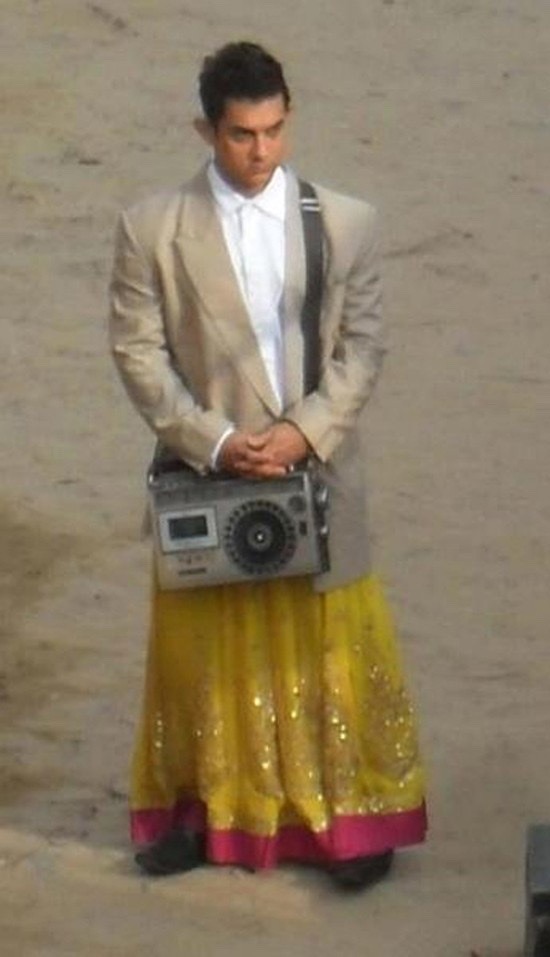
(Since I'm a mixed south-north indian and a hindu-sikh I've mainly included details about indian-hindu characters(ill try to include more abt sikh characters aswell)tho ive tried to include as much info as I can abt other south asian countries aswell !also ,if you want,feel free to add more details in :)
And please forgive my grammar in some of these places XD
1.The most common one,of course being that south asia is not all india.countries like Pakistan, Bangladesh, Nepal, Sri lanka,Bhutan etc exist to.
2.Religion tends to be a big part of many south asian people’s lives , and If not a big part of their life,than most south asians are atleast religious in one way or the other.Different religions are in majority in different regions of south asia.For example,Sri lanka is majority buddhist, mainly in the sinhalese majority while the tamil minority there is majority hindu. But it's more than valid if ur character is atheist to tho!
3.For indian characters specifically ,it's is important to know what state they are from and that state’s culture . For example,most (or almost all)tamil characters won't wear a salwar kameez.(if they do then mostly muslim tamils)(reminder;I'm talking about traditional wear. Yes a lot of Tamil's could wear a salwar kameez if they want but it is not the traditional dress of tamil nadu)
4.India itself is very diverse,so don't make every character hindu.in some regions one religion is more in the majority than the others.If you decide to make a christian-indian character ,than they usually are from south-west india and north-east india.
5.If you decide to make a hindu-indian character as maybe a marvel/dc oc or something , its best to do some research on hindu stories and history.trust me,it helps alot. If not a hindu character than do research on the folk tales of that characters region,as that can help to.
6.NOT EVERY INDIAN SPEAKS HINDI.INDIAN/HINDU ARE NOT LANGUAGES.istg please . All it takes is one search of your characters state and the states description almost always mentions the state’s official language.while some character from non Hindi speaking areas of the country, for example a malyalee person could know how to speak hindi (most probably by living somewhere like delhi),they would still talk in malayalam with family and stuff . Also a pakistani character and Hindi speaking indian can almost always communicate easily since since the most spoken language in Pakistan,Urdu is very similar to Hindi in sound(also a lot of indians,specifically muslim indian’s have urdu as their first language.)Also punjabi Pakistani's and Indian's don't have any problem in communication(the script they write punjabi in is different tho)Also since a lot of people from the north had their ancestors migrate from pakistan to india during partition regional languages of Pakistan such as sindhi,multani,balochi etc can be understood by some people of such descent living in India.And a bengali speaking indian and a Bangladeshi can communicate just as well.Nepali speaking indians and Nepali people can also communicate with each other.But when it comes to Sri Lankan tamil people their dialect is different than the one of indian tamilians,so their tamil is better understood by malyalees,but they can still communicate well enough with each other.afghan people speak pashto and dari.pashto is also understood by a small amount of ethnic pashtuns who live throughout the sub continent.People from the Maldives speak the language of dhivehi.
7.Indians overall have many festivals that all people of usually a certain community celebrate regardless of religion,caste,etc.For example ,the people in kerela celebrate onam.Infact in alot of the state’s people from a specific region have their on festivities.
8.Physical features vary from area to area of South Asia.So there is no definite“south asian“look.
9.Sikh’s don’t cut their hair , that’s why most Sikh women have long hair and most Sikh men wear turbans. Although some do, like my uncle from my mom’s side and my mom herself and etc. Though socially it's more acceptable for a sikh woman to cut her hair then a sikh man. But a load of times sikh immigrants do have to sadly cut their hair and take off their turbans in order to get jobs and all.
10.-And Hindu’s don’t eat beef.Most Sikh’s and overall all Indians tend to avoid beef to.a lot of Hindus are vegetarians due to religious beliefs. Tho mallus and some people from the north east for example usualy do eat beef(mainly the non hindus)
11.-For characters specially from south india(that to mainly kerala and tamil Nadu) the naming tradition that is used most commonly is that the child and wife use the father’s name as their last name. Though I've noticed that outside of their states atleast they tend to use their family names, but very rarely caste names.
12.- Believe it or not, in a show( I'm not sure about the name) a pakistani character had the name“shiv reddy“.pissed me of sm.yes pakistani hindus exist but if I havent already mentioned before,CERTAIN LAST NAMES BELONG TO CERTAIN AREAS. Reddy is an indian telugu hindu last name.please do your research.
13.-This applies to a good amount of north indians and just overall non south indians.south india is not one state.madras was the OLD name for Chennai, which is just one CITY in one state of south india.There are 5 states,6(and more) languages spoken. Please do not confuse those cultures.
14.-As for a good amount of non punjabis...please.punjabis are not all “balle-balle“ sikh people.please. And they're not all angry people looking for a fight either.
15.-Talking abt north india,I need to mention bollywood and how they stereotype.bombay aka the film city is in Maharashtra.yet they still stereotype Maharashtrians as poor people.gujjus are always the rich snobbish ppl.bengali ppl are sweet shy people and nepali people are Chinese. Goans are always english speaking drunkards or high attitude aunties.rajasthanis all have a heavy accent and are royalty and Uttar pradeshis-biharis are poor illiterate people. PLEASE STOP WITH THIS STEREOTYPICAL BULLSHIT ISTG. See,stereotypes exist because they are true, but only a part of the truth and over exaggerated asf.
16.-India does have a poverty issue but we are far from a third world country.most indians are middle class,that to is split in between lower middle class,middle middle class and upper middle class.and until or unless you live in a rural area casteism really isn't a problem.but remember,while casteism is illegal in indian law,it still affects people.it’s just a little less prevelant in big cities. While india is the farthest ahead in south asia atleast the rest of the countries are doing well for themselves as well.
17.-hindu culture specifically has so much lgbtqia+ stuff in it.but the fucking brit’s and Mughals ruined it. The only transgender festival of Asia is held in tamil nadu.seriously, I advise you do research of your own on it and you'll love it to!♥️
18.-Btw, hindi is a language,hindu religion. (had to add this again)Your character prolly from some place like madhya pradesh,bihar,Uttar pradesh,Delhi,uttarakhand or himachal pradesh if they are hindi speaking. Some people have the same confusion with malayalam. Malayalam is a language, malyalee’s are the people who speak it or at from kerala.
19.-talking about food.curry is a wide ass term.wdym by curry?fish curry,mutton curry or is it paneer curry?is it more creamy or not?do you eat it by itself,with rice,a paratha/parotta or all?like seriously stop with “curry“ ITS ANNOYINGGG.again food varries alot area by area.even in a specific area food varries. For example,Kerala-Tamil nadu sambar is damn spicy but sambar from karnataka and telugu states tends to be sweeter.also food from Karnataka is much milder in spice then food from Andhra,but still capable of burning the mouths of most non south asians 😍😘🥰.also,we tend to eat most of our food with hands(THE best way.)famous delicacies vary from country to country in south asia and area to area of india btw. And our food is not ’smelly’, it's FRAGRANT.
20.ok so ive in total had 2 specific segments dedicated to language and this is the third one.India,while having only 22 offical languages(again;i remind you,we do not have a national language)actually has like thousands of languages. Native people from even just one state can have different mother tongues(for example-three people who were born and raised in karnataka and have families that are native to the state could have the languages of kannada,tulu and kodava as their mother tongues).And again,dialects also differ.For example,Bombay hindi and the hindi of a person from Uttarakhand would be different, and so would Bangalore tamil and a Madurai native’s tamil.Also,let’s say a telugu person has been living in mumbai for a while,very rarely will they ever have an ’accent’ while speaking hindi or english.
21.so above i mentioned that alot of people from the north have had ancestors move in from pakistan during the partition(and vice versa for some Pakistani's).Similarly,a good amount of people from west bengal had their ancestors move in from bangladesh(and vice versa again,but unlike the north india-pakistan thing indian bong’s and bangladeshi people don’t exactly have that ’divide’).Adding this in specifically not only because of how important this is but it can give more depth to your characters if they are from any of these areas.
22.Every state has different art forms.be it dance,music or just art,every state has it different.India has 8 classical dances(bharatanatyam,kuchipudi, mohiniyattam,kathakali,oddisi,kathak, manipuri and sattriya) and has countless many more.Music also varies and so does art as i said above.
23.our culture is super feminist but fucked by the brits and mughals again. We had so many queens and princesses that fought wars and also many female warriors.In the ancient times women only wore single drape saris and didn’t cover their breasts because they were not seen as sexual,but infact as a sign of motherhood(and there forth strength).If they were covered,it was for support.
24.Most people know atleast 3+ languages and almost everyone knows 2 at the very least. Sometimes they can even understand(which can range from basic to great) some other languages. For eg.- my dad can speak english,hindi,telugu,konkani,tulu,punjabi,urdu and multani+ he can understand malayalam,kannada,sindhi and tamil well enough.
That's it(for now):) hope this can help.feel free to ask questions!+random songs from my playlist✨✨✨
(ps,check this post of mine out cause y not lol)
#indian#desi culture#writing#south asia#desi character#hinduism#desi academia#desi aesthetic#desi tag#Spotify#desi tumblr#desi shit posting#Indian culture#writing advice#character#character writing#all is not well#desi#desiblr#desi shit
359 notes
·
View notes